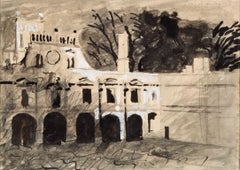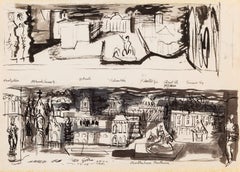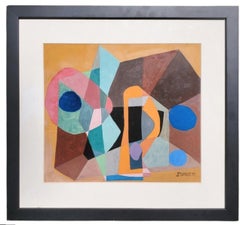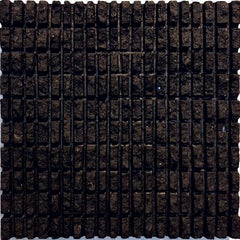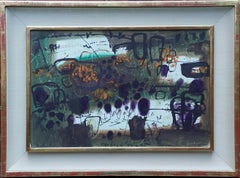John Piper Paintings
British, 1903-1992
Born in Epsom, John Egerton Christmas Piper studied at Richmond School of Art and the Royal College of Art from 1926-8. In the mid 1930a, after a visit to Paris, he turned to abstraction. He became a member of the London Group in 1933 and the ‘Seven and Five’ group in 1934-5. During this period he became friends with Oliver Simon of the Curwen Press and his interest in lithography and print making grew. During the Second World War, Piper was appointed as an official war artist recording the effects of the blitz on Britain’s buildings. After the war, he became a Trustee of the Tate and National Galleries and in 1959 he became a member of the Royal Fine Art Commission. Piper is best known for his extensive studies of British architecture and landscape in oil, watercolour and print, and for his photography, stained glass, ceramics, fabric design, murals, stage sets and costume design. His work is held in many Museums and Galleries.3
Overall Width
to
Overall Height
to
3
3
2
1
1
1
19
781
717
711
694
3
3
Artist: John Piper
Kirby Hall, Northamptonshire, Gouache with Ink and Wash Painting, 1940-42 circa
By John Piper
Located in Kingsclere, GB
Kirby Hall, Northamptonshire, Gouache with Ink and Wash Painting, 1940-42 circa
Additional information:
Medium: Gouache with ink and wash
15.2 x 18.5 cm
6 x 7 1/4 in
As part of an eight-page pamphlet for The Colour of English Country Houses in 1944, Piper included a lovely auto-lithograph of Kirby Hall in Northamptonshire. This work was most likely sketched on the occasion of his visit to the Hall at this time and is of a slightly different angle. It is a working version of the cover of C Aspinall-Oglander's 'Admiral’s Widow’, 1942 (Hogarth Press). The print is cat. no.51.\\\
Piper gives a lovely description of this Elizabethan country house in the introduction to the pamphlet as follows: ‘A yellow stone house of the seventeenth century, in rolling green hunting-country. It gleams in the sun, forms a warm eye-catcher in dull weather and glimmers whitely in moonlight. It is another ruin, partly roofless, and has recently taken over by the Office of Works to be preserved as a show-place.’ (John Piper). Here, Piper, painting at night in the light of the moon, depicts the north front from the inner courtyard, capturing the brilliance of the moonlit night as it dances over the ruins making it in Piper’s own words ‘glimmer whitely’ whilst the dramatic shadows darken the archways and windows.
John Piper was a painter of architecture, landscape and abstract compositions, a designer for the theatre and of stained-glass windows, and a writer on the arts.
Piper was born in 1903 in Epsom, Surrey, the son of a solicitor. Throughout his childhood, he regularly visited Italy, and by 1924 he had published a book of poems and his own illustrations. He worked in his father's office in Westminster until 1928 when he began studying at the Richmond and Kingston Schools of Art. This was followed by two years study at the Royal College of Art. In 1927 he exhibited with David Birch at the Arlington gallery, and in 1931 with Clarice Moffat, P. F. Millard, and his first wife Eileen Holding...
Category
20th Century John Piper Paintings
Materials
Gouache
Cheltenham (Fantasia/Panorama), Pen and Ink Painting by John Piper, 1939 circa
By John Piper
Located in Kingsclere, GB
Cheltenham (Fantasia/Panorama), Pen and Ink Painting by John Piper, 1939 circa
Additional information:
Medium: Pen and ink
19 x 26.5 cm
7 1/2 x 10 3/8 in
Inscribed extensively
The upper image closely resembles a 1940 painting, Cheltenham Fantasia, which was sold to a Mr Anderson at the Leicester Galleries in March of that year. The lower image is a study for Piper's 1940 Curwen Press auto-lithograph 'Cheltenham', produced while he was also working on illustrations for the Shell and BP Shilling Guide to Gloucestershire (1939; not used in the project). Betjeman, then head of the project, also used the image to illustrate his article "Book Illustration Can Colour a Whole Town or City" in 'Signature' in 1940. The Cheltenham design is covered and reproduced in Hugh Fowler-Wright's book on Piper.
John Piper was a painter of architecture, landscape and abstract compositions, a designer for the theatre and of stained-glass windows, and a writer on the arts.
Piper was born in 1903 in Epsom, Surrey, the son of a solicitor. Throughout his childhood, he regularly visited Italy, and by 1924 he had published a book of poems and his own illustrations. He worked in his father's office in Westminster until 1928 when he began studying at the Richmond and Kingston Schools of Art. This was followed by two years study at the Royal College of Art. In 1927 he exhibited with David Birch at the Arlington gallery, and in 1931 with Clarice Moffat, P. F. Millard, and his first wife Eileen Holding...
Category
20th Century John Piper Paintings
Materials
Ink
Foot of Pistyll Rhaeadr, Ink and Wash Painting by John Piper, circa 1939-1941
By John Piper
Located in Kingsclere, GB
Foot of Pistyll Rhaeadr, Ink and Wash Painting by John Piper, circa 1939-1941
Additional information:
Medium: Ink and wash
12.5 x 17.7 cm
4 7/8 x 7 in
Titled under the mount
John Piper was a painter of architecture, landscape and abstract compositions, a designer for the theatre and of stained-glass windows, and a writer on the arts.
Piper was born in 1903 in Epsom, Surrey, the son of a solicitor. Throughout his childhood, he regularly visited Italy, and by 1924 he had published a book of poems and his own illustrations. He worked in his father's office in Westminster until 1928 when he began studying at the Richmond and Kingston Schools of Art. This was followed by two years study at the Royal College of Art. In 1927 he exhibited with David Birch at the Arlington gallery, and in 1931 with Clarice Moffat, P. F. Millard, and his first wife Eileen Holding...
Category
20th Century John Piper Paintings
Materials
Ink
Related Items
Geometric Shapes
By Rolph Scarlett
Located in Saratoga Springs, NY
Rolph Scarlett (1889-1984)
Geometric Shapes
Gauche on Paper
14 ½" x 13”
22" x 21" framed
In this original artwork, the artist transforms circles, shapes, and lines within an ide...
Category
1950s Abstract John Piper Paintings
Materials
Gouache, Archival Paper
Small contemporary modern black wall sculpture painting relief BK15RT
By Dieter Kränzlein
Located in Doetinchem, NL
BK15RT is a unique small size contemporary modern wall sculpture painting relief by German artist Dieter Kränzlein. This sculpture relief is carved from a single block of limestone, ...
Category
2010s Contemporary John Piper Paintings
Materials
Limestone
$583
H 5.91 in W 5.91 in D 0.79 in
Small contemporary modern yellow wall sculpture painting relief YEN15LHV
By Dieter Kränzlein
Located in Doetinchem, NL
YEN15LHV is a unique small size contemporary modern wall sculpture painting relief by German artist Dieter Kränzlein. This sculpture relief is carved from a single block of limestone...
Category
2010s Contemporary John Piper Paintings
Materials
Limestone
$583
H 5.91 in W 5.91 in D 0.79 in
"Labyrinth" Acrylics and Ink on Paper in Hues of Raw Umber, Black and White
By Karina Gentinetta
Located in New York, NY
"Labyrinth" 2021, 23.5" x 21.5" vertical drawing on paper by Argentine-born artist Karina Gentinetta (featured in Elle Decor, Architectural Digest, New York Times, Traditional Home, ...
Category
21st Century and Contemporary Abstract Expressionist John Piper Paintings
Materials
Glaze, Ink, Acrylic
$4,850
H 23.5 in W 21.5 in D 1 in
"Auspice" (Abstract, Colorful, Textured Skull Painting on Antique Wood, 65x50cm)
By Nicholas Evans
Located in Paris, IDF
AUSPICE
2020
Paris, France
An auspice is a ‘prophetic sign’ which the artist was inspired by. This textured, abstract piece features a lying skull, looking up to the sky...
Category
21st Century and Contemporary Abstract John Piper Paintings
Materials
India Ink, Oil, Acrylic, Wood Panel
Nicholas Evans"Auspice" (Abstract, Colorful, Textured Skull Painting on Antique Wood, 65x50cm), 2020
$640 Sale Price
20% Off
H 25.6 in W 19.69 in D 0.69 in
Phenomena Royal House
By Paul Jenkins
Located in New York, NY
Paul Jenkins
American, 1923–2012
Paul Jenkins’s intuitive, chance-based painting techniques helped pioneer new approaches to Abstract Expressionism. Jenkins made his vibrant composi...
Category
Late 20th Century American Modern John Piper Paintings
Materials
Paper, Gouache
Small contemporary modern blue wall sculpture painting relief BLN15LHV
By Dieter Kränzlein
Located in Doetinchem, NL
BLN15LHV is a unique small size contemporary modern wall sculpture painting relief by German artist Dieter Kränzlein. This sculpture relief is carved from a single block of limestone...
Category
2010s Contemporary John Piper Paintings
Materials
Limestone
$583
H 5.91 in W 5.91 in D 0.79 in
Metamorphosis II - abstract painting, made in black, grey color, ink
By Mila Akopova
Located in Fort Lee, NJ
Interior design paintings. The work was done with india ink in black and grey color on Yupo paper. The work is 11 by 14 inches in size, framed 16 by 20 inches.
Mila Akopova is New ...
Category
2010s Abstract John Piper Paintings
Materials
Paper, India Ink
“So Plant, So Animal II” (Graphic, Bold, Abstract, Neutral, Framed Painting)
By Nicholas Evans
Located in Paris, IDF
Bold yet delicately portrayed, "So Plant, So Animal II" is an abstract piece framed to perfection, offering a timeless neutral color palette. The central theme captures the essence o...
Category
21st Century and Contemporary Abstract John Piper Paintings
Materials
Linen, Wood, India Ink, Acrylic
$1,950
H 25.79 in W 21.26 in D 1.38 in
'Migration: In Flux Pandemic Collection, ' by Peter Healy, Painting, 2020
Located in Oklahoma City, OK
This framed 27" x 37" watercolor painting by Irish artist, Peter Healy is from the 'In Flux' Pandemic Collection. The painting comes vibrantly alive as the...
Category
2010s Abstract John Piper Paintings
Materials
Ink, Watercolor, Paper
$1,088 Sale Price
24% Off
H 27 in W 37 in D 1.5 in
Abstract Floating Overlapping Shapes, Black and White Painting, Pastel Gestures
By Ryan Rivadeneyra
Located in Barcelona, ES
This is a hand-painted acrylic painting on high-quality 300g paper by artist Ryan Rivadeneyra. These painting, influenced by modernist artists of the 50's, 60's, and 70's, explore ab...
Category
2010s Post-Modern John Piper Paintings
Materials
Oil Crayon, India Ink, Handmade Paper
Kronen-Narr by Paul Klee
By Paul Klee
Located in New Orleans, LA
Paul Klee
1879-1940 Swiss-German
Kronen-Narr
(Crown Fool)
Signed "Klee" (lower right)
Gouache and ink on newsprint on cardboard
One of the most important artists of the 20th cent...
Category
20th Century John Piper Paintings
Materials
Ink, Gouache, Cardboard, Newsprint
Previously Available Items
Abstract Landscape - Mendham Suffolk 1965 - British Abstract landscape painting
By John Piper
Located in Hagley, England
This superb vibrant British Abstract painting is by noted artist John Piper. It was painted 27th October 1965 at Mendham and is a watercolour and gouache composition. The stunning palette and brushwork make this a really colourful and engaging painting. It is in excellent condition as it is behind glass. A lovely example of Piper's work with echoes from the sixties.
Signed lower right. Inscribed lower middle 'Mendham 27 X 65'.
Provenance. Illustrated in black and white on the back cover of Marlborough/Aldeburgh Festival show catalogue 'John Piper, Suffolk Churches and Landscapes', 1966.
Condition. Watercolour and gouache, 21 inches by 14 inches and in good condition.
Frame. Housed in a generous surround float mounted frame and behind glass, 28 inches by 21 inches and in good condition.
John Egerton Christmas Piper CH (1903-1992) was an English painter, printmaker and designer of stained-glass windows and both opera and theatre sets. His work often focused on the British landscape, especially churches and monuments, and included tapestry designs, book jackets, screen-prints, photography, fabrics and ceramics. He was educated at Epsom College and trained at the Richmond School of Art followed by the Royal College of Art in London. He turned from abstraction early in his career, concentrating on a more naturalistic but distinctive approach, but often worked in several different styles throughout his career. Piper disliked the regime at the Royal College of Art and left in December 1929. Piper and his wife lived in Hammersmith and held a joint exhibition of their artworks at Heal's in London in 1931. Piper also wrote art and music reviews for several papers and magazines, notably The Nation and Athenaeum. One such review, of the artist Edward Wadsworth's work, led to an invitation from Ben Nicholson for Piper to join the Seven and Five Society of modern artists. In the following years Piper was involved in a wide variety of projects in several different media. As well as abstract paintings, he produced collages, often with the English landscape or seaside as the subject. He drew a series on Welsh nonconformist chapels, produced articles on English typography and made arts programmes for the BBC. He experimented with placing constructions of dowelling rods over the surface of his canvases and with using mixtures of sand and paint. With Myfanwy Evans, Piper founded the contemporary art journal Axis in January 1935. As the art critic for The Listener, through working on Axis and by his membership of the London Group and the Seven and Five Society, Piper was at the forefront of the modernist movement in Britain throughout the 1930s. In 1935 Piper and Evans began documenting Early English sculptures in British churches. Piper believed that Anglo-Saxon and Romanesque sculptures, as a popular art form, had parallels with contemporary art. Through Evans, Piper met John Betjeman in 1937 and Betjeman asked Piper to work on the Shell Guides he was editing. Piper wrote and illustrated the guide to Oxfordshire, focusing on rural churches. In March 1938 Stephen Spender asked Piper to design the sets for his production of Trial of a Judge. Piper's first one-man show in May 1938 included abstract paintings, collage landscapes and more conventional landscapes. His second in March 1940 at the Leicester Galleries, featuring several pictures of derelict ruins, was a sell-out. Piper had first met Myfanwy Evans in 1934 and early the next year, when his wife Eileen left him for another artist, Piper and Evans moved into an abandoned farmhouse at Fawley Bottom in the Chilterns near Henley-on-Thames. The farmhouse had no mains electricity, no mains water and no telephone connection. They married in 1937. They gradually converted the farm's outbuildings to studios for their artworks, but it was not until the 1960s that they could afford to modernise the property. Piper was an official war artist in World War II and his wartime depictions of bomb-damaged churches and landmarks, most notably those of Coventry Cathedral, made Piper a household name and led to his work being acquired by several public collections. Piper collaborated with many others, including the poets John Betjeman and Geoffrey Grigson on the Shell Guides, the potter Geoffrey Eastop...
Category
1960s Abstract John Piper Paintings
Materials
Watercolor, Gouache
John Piper, Rock-Face, Modern British, Oil on Panel, 20th Century, Abstract
By John Piper
Located in Eversholt, Bedfordshire
John Piper (British,1903-1992) : Rock-face
Signed 'John Piper' (lower right) Signed and inscribed with title (verso)
Oil on panel
Executed in 1950 according to Buchholz Gallery label verso
Provenance: Buchholz Gallery (Curt Valentin), New York
Exhibited: Bucholz Gallery (Curt Valentin), John Piper, Recent Work, October 17th–4th November, 1950, Cat. no. 10
Related to: In the monograph on Piper by John Woods, the picture most like it is a larger oil, Rock Face, Cwm Tryfan 1950, plate 121, collection of Museum of Modern Art, New York. Rock-face is probably an observation at Tryan also.
Reference: John Piper : Special Exhibition, Blenheim Palace until 9th April. The Mountains of Wales, National Museum Cardiff, until 9th May
Height 15.8 cm., 6 ¼ in., Length 20 ½ cm., 8 in.,
In a color washed, bevelled frame
Frame Height 35 cm., 13 ¾ in., Length 40 cm., 15 ¾ in.
John Piper is famous for architecturally detailed pictures of houses, churches and ruins. As S. John Woods writes in John Piper: Painting, Drawings and Theatre Designs 1932-1954 (London: Faber & Faber, 1954) 'his approach was that he wanted to paint a house as if he were designing it, understanding not just its appearance but its anatomy and its sentiment’. John Carter wrote in an exhibition catalogue, that Piper, is 'acutely aware of the bones of a building.'' This approach Piper also brought to his landscape paintings, and it is clear in the present work. A sense of painting while keeping at the front of the mind the inner structure of the stone in front of him; its age and architecture. There is the sense of the boulder as the result of someone's intention, as an object of a Creation.
In British Romantic Artists (London: William COX, 1942) John Piper wrote: 'Romantic art is the result of a vision that can see in things something significant beyond ordinary significance: something that for a moment seems to contain the whole world; and, when the moment is past, carries over some comment on life or experience beside the comment on appearances.'
In 1950 John Piper was well into his post-war period which was characterised by techniques such as the scratching in the oil paint apparent in the present work, a more sombre palette generally, and a concentration on landscape and natural features, particularly those of Portland in Dorset, where his fascination for geology in a form which has been changed by man could have full rein in the quarry; and also, extensively, those of North Wales, which he had been visiting since a commission in 1943 to paint the underground quarry in which the Nation Gallery's collection of art was being stored for the duration of the war. He returned for periods of the winter over the next seven or eight years, for part of that time, including in 1949-50, renting a cottage at Bodesi, below the Tryfan Mountain. Boulder fields at Bodesi, Bodesi Farmhouse, 2011
Here there was much inspiration: in the extreme geology of the land, and in the effect of winter light on mountains. Piper was inspired by the IDEA of the sublime, and the eighteenth century landscape work of Richard Wilson, and spent time trying to locate Wilson's viewpoints. Richard Wilson, Llyn-y-Cau, Cader Idris, 1774
Cited in John Piper: Painting, Drawings and Theatre Designs 1932-1954 (London: Faber & Faber, 1954), Piper is quoted as saying: 'In paintings of North Wales, as of many mountain areas, a rock in the foreground often shows the same form and, in its fractures and the way it lies, the same direction as the whole mountain range in the distance'. Boulder at Cwm Tryfan
In the same book, S John Woods writes: 'the near abstract paintings he did about 1950, based on rocks and walls, are among his best works'. Writing in The Listener on March 29 1933, (the article entitled Younger English Painters II) Piper quotes DH Lawrence writing in 1915: ''One can only build great abstraction out of concrete units... The architecture comes in painting only with the suggestion of some whole, some conception which conveys in its own manner the whole universe. Most puerile is this clabbing of geometric shapes behind one another, just to prove that the artist is being abstract, that he is not attempting the representation of the object. The way to express the abstract whole is to reduce the object to a unit, a term, and then out of these units and terms to make a whole statement''.
Piper's landscapes and works with a natural subject are knowingly situated in the traditions of landscape painting reaching back to the seventeenth century. In the seventeenth century landscape painting was an expression of religion - the veneration of that which is made by the hand of God. In the eighteenth century, the century of Enlightenment, it became an expression of the Cult of Nature - venerating the rules and laws which were being derived and discovered in the natural world. Piper's approach, of spending long periods of time in order to understand and express the intrinsic nature of the rock in front of him is very much a development of this long tradition, and a clear in the present work. As Woods wrote: 'These (paintings of North Wales) are not dramatised, but their greys and browns and black are rich with the sense of place and climate'.
John Piper, a note written near the Summit of the Glyders, Snowdonia: ' Mist blowing across all day: visability about 15 - 20 yards only, curious sensation in presence of gigantic boulders, giant coffin slabs, pale trunk-shaped rocks, disappearing into grey invisibility even at close range. The affectionate nature of the mountain not changed by the acute loneliness and closed-in feeling induced by the mist'.
‘ I felt then that I was seeing the mountains for the first time and seeing them as nobody had seen them before. This was due partly to the feeling of release after the confining of the war, partly to a “spurt” in my capacity to observe more clearly at this particular time. Each rock lying in the grass, had a positive personality: for the first time I saw the bones and structure and the lie of the mountains, living with them and climbing them as I was, lying on them in the sun and getting soaked with rain in their cloud cover and enclosed in their improbable, private rock-world in fog.’ Pipers Places, p105.
Rock-face was painted in 1949-50 when Piper was renting Bodesi farmhouse and is most likely that it is an observation of rocks at Tryfan which is nearby. In Rock Face, the rock has become metaphorical and, of an extraordinary grandeur, both observed and painted in abstract form. ‘ In his search to find the exact color of the rocks Piper imaged them to be animals feeling the shades of the weather, “ sometimes antagonistic ” as “ they react “. The paradigm of his drawings of Snowdonia was often the relation between a prostrate foreground and a distant background Summit, one pinkish and one bluish. The shapes are intricate and crafted, yet on a scale beyond human, apparently the realm of the “ enormous and untidy race of men ‘. He was surely contemplating mortality. ‘ David Fraser Jenkins
The coloring in Rock Face is bold and intense, typical of the oils executed in 1950, illustrating Piper as a brilliant colorist. ‘ The rocks can only look grey in leaden light, and then do not, commonly. Against mountain grass or scree, against peaty patches near tarns, on convex slopes, in dark cwms, the same kind of rock can look utterly different, and changes equally violently in color according to the light and time of year. ‘ JP. ‘ Lake frozen, from west end under the crags reflecting the sky – palest blue Zenith, fading downwards through orange and pinkish orange to translucent grey in reverse. White frosty rock surfaces contrasting violently with dark and shadowed ones.’ Diary entry 17th January 1946 Whether Piper intended to use the metaphor of the rock-face as a device to show human mortality or to show the effect of the weather on the rock-face is debatable. It is true that there is a small group of abstracted oils executed at this time and Rock-face appears to be the most abstracted version. Glyders Rocks, 1950, Oil, 20x29, SJ Woods, no 120. Rock Face, Capel Curig, oil 28x36, 1950, SJ Woods, no 119.
Figurative work appears in Piper’s stained glass designs. Foliate or ‘leafy’ heads are perhaps one of Piper’s most distinctive motifs, appearing in his works in a variety of media including tapestries and ceramics as well as drawings, paintings and prints. Their form is based loosely on traditional ‘green men’, found in the architecture of many medieval and nineteenth-century buildings. The recurrence of the image perhaps reflects Piper’s fascination with detailed medieval church carvings...
Category
1950s Modern John Piper Paintings
Materials
Oil, Panel
H 6.23 in W 8.08 in D 0.79 in
John Piper paintings for sale on 1stDibs.
Find a wide variety of authentic John Piper paintings available for sale on 1stDibs. You can also browse by medium to find art by John Piper in paint, gouache, watercolor and more. Much of the original work by this artist or collective was created during the 20th century and is mostly associated with the modern style. Not every interior allows for large John Piper paintings, so small editions measuring 9 inches across are available. Customers who are interested in this artist might also find the work of William Gear, Edmund Quincy, and Hans Gustav Burkhardt. John Piper paintings prices can differ depending upon medium, time period and other attributes. On 1stDibs, the price for these items starts at $25,462 and tops out at $44,734, while the average work can sell for $35,098.
Artists Similar to John Piper
Questions About John Piper Paintings
- 1stDibs ExpertOctober 24, 2024How much John Piper paintings are worth varies based on their size, historical significance, condition and other factors. In 2013, his 1935 piece Painting sold for £482,500 at an auction in London. Piper is best known for his extensive studies of British architecture and landscape in oil, watercolor and print, and his photography, stained glass, ceramics, fabric design, murals, stage sets and costume design. His work is held in the collections of many major museums, including the Museum of Modern Art in New York and the Tate in London. If you are the owner of a Piper, a certified appraiser or experienced art dealer can assist you with the valuation process. On 1stDibs, shop a range of John Piper art.
- 1stDibs ExpertAugust 20, 2024How much a John Piper painting is worth depends on its condition, history and other factors. In November 2013, his 1935 work Abstract Painting sold for more than $617,000, setting an auction record for the British artist. Piper is best known for his extensive studies of British architecture and landscapes in oil, watercolor and prints. In the mid-1930s, after a visit to Paris, he turned to abstraction, and his record-setting work reflects this shift in his style. If you own a Piper painting, a certified appraiser or knowledgeable art dealer can give you an estimate of its value. On 1stDibs, explore a selection of John Piper art.
